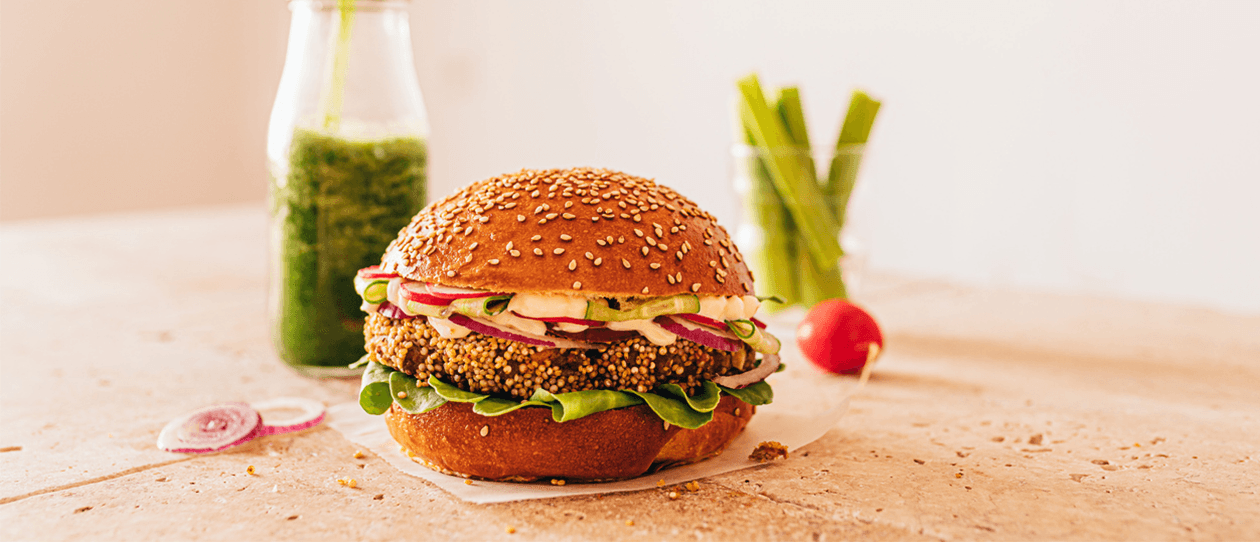
- Health hub/
- Tips & Advice on Improving your Everyday Health/
- The 5 Best Plant-Based Meat Alternatives


Plant-based meat products are designed to replace the real meat in your favourite meals. At your local supermarket, you may find plant-based burger patties, sausages, mince and chicken.
The trend is also growing in restaurants and popular fast-food chains, adding plant based ‘meat’ burgers to their menus.
What is in plant-based meat alternatives?
Meat is made up of a few main components of protein, fat, and water. While different plant based meat brands use different ingredients, many of them aim to recreate this core structure in their products. Some of the more common ingredients in these products, other than water, include vegetable protein from soy, pea, mung bean, potato protein, wheat, rice, or mycoprotein (a product derived from fungi) or a combination. They are often listed as 'protein isolate', or 'textured vegetable protein.'
To simulate real meat, fat is added to bind the food together and provide an authentic ‘meaty’ flavour. For these meat alternatives, vegetable oil such as coconut or canola oil is used.
Other ingredients added include salt, starch from potato, tapioca, corn or maize, plant fibre, often from peas and thickeners. Beetroot is used in some plant based products such as burgers, both for its taste, and because the colour of red beet juice aims replicate the ‘bleeding’ of red meat when it’s cooked on a grill or barbeque.
Soy protein
Soy protein from the legume soybean, has been successfully used in the preparation of meat alternatives, due to its excellent gelatin properties and potential to form fibrous structures. Meat alternatives are typically made using concentrated sources of soy protein, such as soy protein isolate and soy protein concentrate.
Soybeans are an excellent source of high quality protein, which most other legumes lack, which makes it a great meat alternative to protein from animal foods, many of which contain high levels of saturated fat and dietary cholesterol.
Soy foods are also high in fibre, omega 3 fats, B vitamins, iron, zinc. These can be found in ‘meat’ patties or you can add tofu into your stir-fry.
Pea protein
Pea proteins are nutritionally complete, packed with protein, supplying all nine essential amino acids humans need. Pea protein is derived from common split peas. They are also free from many of the common allergens from wheat, soy and animal products.
It’s also easily digestible, easy on your stomach, unlike high-fat meat products. Textured pea protein is mostly used to make meat alternative products.
Mung bean protein
Mung bean is a widely cultivated plant in many Asian countries as well as in dry regions of southern Europe and warmer parts of Canada and the United States. Mung bean seeds contain slightly higher protein content than soy.
More recently, mung bean extracts, especially protein and peptide isolates, have been added to different foods to increase the nutritional content of the foods or to enhance specific types of foods like alternative meat products.
Wheat protein
The name "seitan" is another name for this wheat protein that is made from wheat gluten, the protein that helps wheat flour stick together and makes bread spongy. Seitan is often used to make mock meats and is frequently used in vegetarian Chinese cuisine.
Although it is made from wheat, seitan has little in common with flour or bread. It has a very similar look and chewy texture to meat when cooked. It is made by rinsing away the starch in the wheat dough, leaving just the high-protein gluten behind. It has a texture that more closely matches meat than other alternatives such as tofu. Seitan has a savoury taste, like bland chicken or a portobello mushroom. It is not suitable for gluten free diets.
Mycoprotein
Mycoprotein is protein made from a type of fungus, known as Fusarium venenatum, that was found in the wild and developed specifically for the production of food-grade protein.
The protein quality is similar to that of soybeans while its texture is similar to that of chicken breast. Mycoprotein is high in protein and fibre, and low in fat, cholesterol, sodium, and sugar.
It is made from the process of fermentation. It has now been on the market under the brand name, Quorn™ in many different countries. Because it's made from a fungus, it's possible that some people who react to other fungi or moulds may also react to mycoprotein.
Are plant based meat alternatives healthier?
Australian Dietary Guidelines recommend a diet with plenty of vegetables, of different types and colours, and legumes and beans. On the plus side, these meat alternatives are quite often lower in fat, particularly saturated and some have added fibre, which you won't get from meat.
However, these plant based meat alternatives are still processed foods, unlike whole plant foods. They can also often be high in salt so it would be ideal to check the nutritional panel for the salt content.
They may be a good supplement and for occasions where you would like a plant based alternative to the meat patty or meat bolognese. However they are not intended to be a replacement for your intake of vegetables and proteins from whole plant foods.




